When Real Madrid and Liverpool were drawn together, a 2017/18 Champions League final grudge match was the storyline. That night in Kyiv ended 3-1 in Real Madrid’s favour, but Sergio Ramos’ involvement in the Mohamed Salah injury dominated the news.
Out for revenge, Salah and Liverpool arrived at the Estadio Alfredo Di Stéfano in good form, demolishing Arsenal over the weekend. Their hope of getting a result received a boost when Ramos picked up a knock during international duty, that on top of Eden Hazard’s recurring injuries.
However, just like the final in Kyiv, the first leg of the 2020/21 quarterfinals ended 3-1 in favour of Los Merengues. This tactical analysis will detail the major catalysts of the Madrid win, starting with an analysis of Liverpool’s plan of attack and the Real response. From there, we’ll analyse Liverpool’s issues in the high and middle press, then show how Madrid punished them.
Lineups
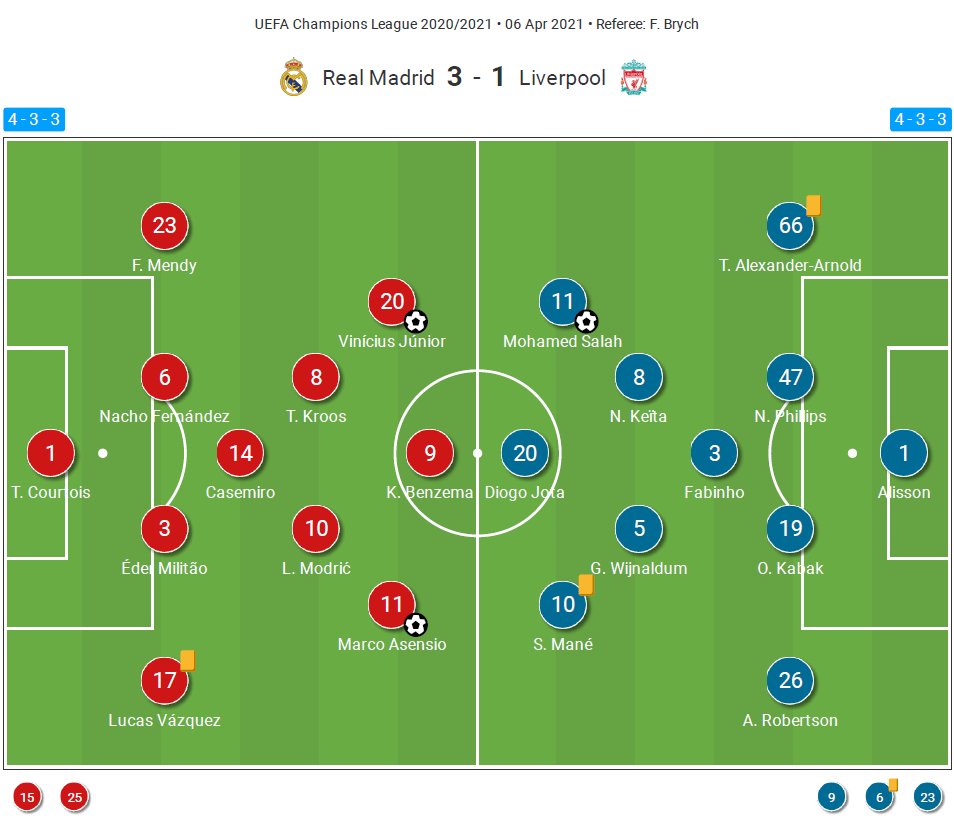
Some speculated Zinedine Zidane could use a 3-5-2 in this match, but Raphaël Varane’s positive COVID-19 test ruled him out of the contest led the manager back to his standard 4-3-3. Thibaut Courtois took his place in goal with just one normal starter along the backline, that being Ferland Mendy. The Frenchman’s bookend was Lucas Vázquez while Nacho Fernández and Éder Militão manned the centre. Casemiro was the pivot, joined by Toni Kroos and Luka Modrić in midfield. From right to left, the Los Blancos forward line consisted of Marco Asensio, Karim Benzema, and Vinícius Júnior.
On the other side of midfield, Jürgen Klopp had the moustachioed Alisson in goal with Nathaniel Phillips and Ozan Kabak at centreback, flanked by Trent Alexander-Arnold and Andy Robertson. In midfield, the Reds started the trio of Fabinho, Naby Keïta and Georginio Wijnaldum. Diogo Jota beat out Roberto Firmino to the #9 in the starting XI while Salah and Sadio Mané rounded out Klopp’s 4-3-3.
Liverpool’s attack vs Real Madrid’s press
Coming into the match, Real Madrid’s losses along the backline raised a red flag. Would the backline hold up against the star-studded Liverpool front three? Could Madrid do enough defensive work higher of the pitch to limit the threats their backline would encounter?
For Liverpool’s part, especially after a dominant performance against Arsenal, all indications pointed to a big day from the front three. With Jota starting in place of Firmino, there was the necessary quality on the pitch to take advantage of Real Madrid’s high line. With the front three stretching the backline, they could then look for Alexander-Arnold and Robertson to provide width through the gaps in Real Madrid’s formation.
To combat Liverpool’s barrage of crosses from the outside-backs, Zidane gave the hard-working Vinícius Júnior the start on the left. His work rate and intensity we’re matched on the right by Asensio. When Real Madrid defended in the middle and low blocks, the two wingers would often drop in line with Casemiro, giving Real Madrid a 4-5-1 or 4-3-2-1.
In the first half, we mostly saw the former. In this instance, Liverpool had some success in attack finding Alexander-Arnold behind Vinícius Júnior. As the young Englishman received the ball, he took an aggressive first touch towards the Real Madrid backline.
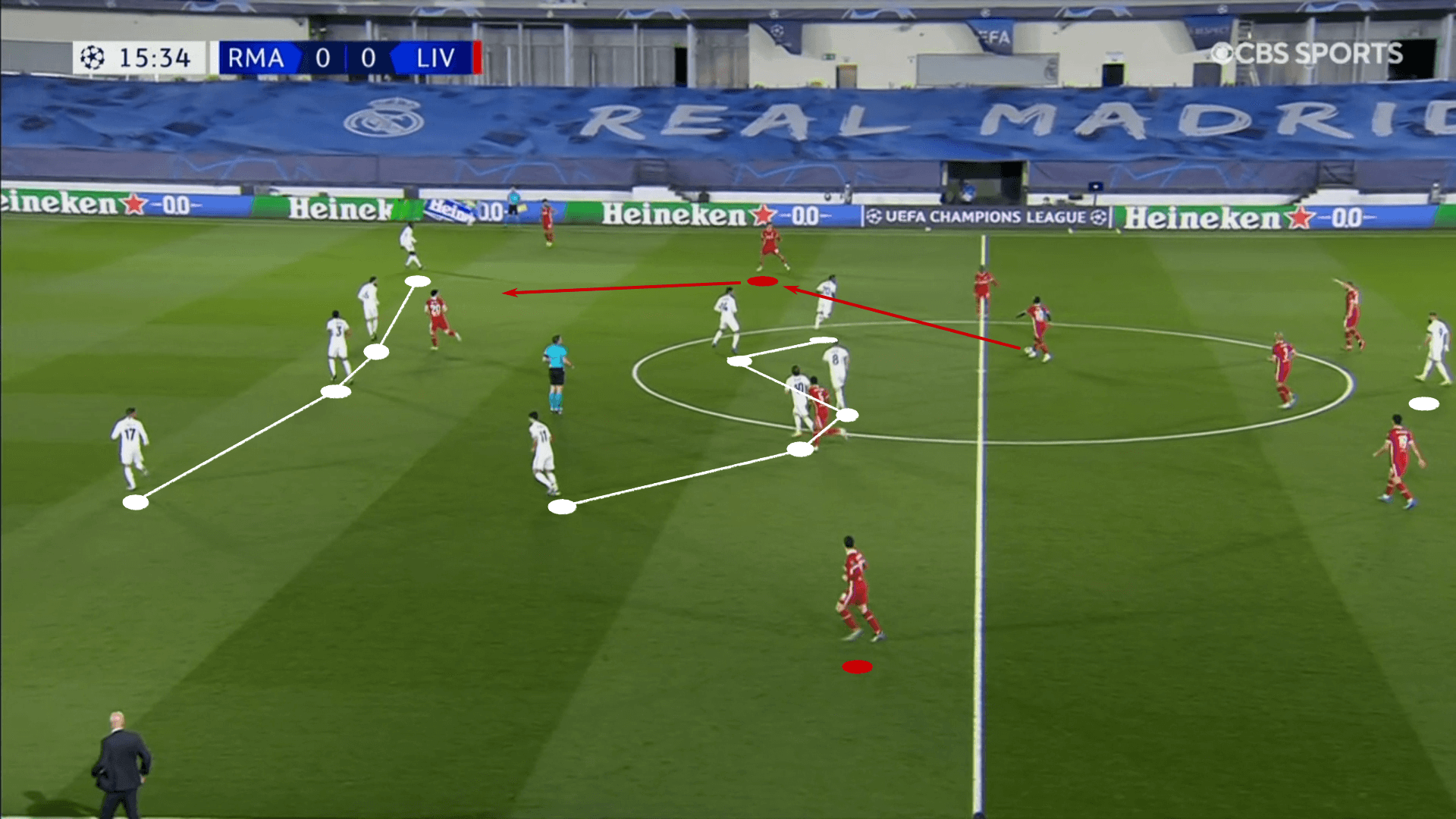
From a defensive standpoint, Zidane’s reason for dropping Vinícius Júnior and Asensio was to limit Alexander-Arnold and Robertson’s time of the ball as they entered the final third, contesting them each time they attempted to drive the attack on goal from the wide spaces.
In this particular sequence, TAA was able to drive into the half space. However, an excellent recovery from Real Madrid’s midfield forced him to release his pass before he could pin the backline. As he looked a play into Wijnaldum, Militão was prepared to step forward and clear the ball.
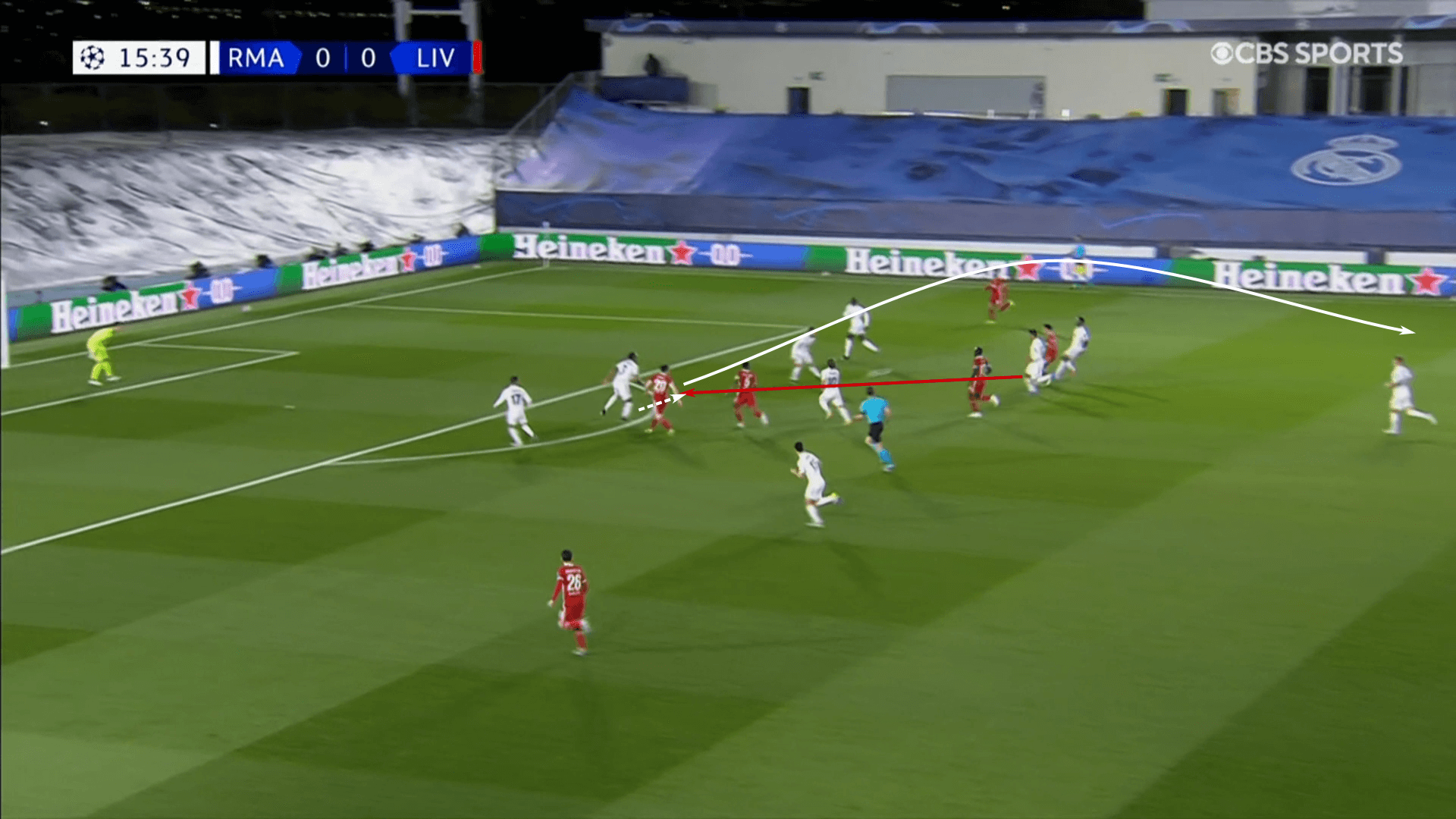
Though Liverpool didn’t generate a shot on this positional attack, it was an early warning to the host, signalling that they needed to tighten up their lines and limit Liverpool’s two wide playmakers. To their credit, Los Blancos heeded the message, limiting Liverpool to seven total shots with just one finding its way to the frame, which accounts for Liverpool’s goal.
One of the catalysts for Real Madrid success was the defensive performances of the two wide forwards. Vinícius Júnior and Asensio played a selfless match, remaining focused on their tactical objectives and sacrificing to limit the Reds outside-backs.
The 4-5-1 work perfectly. In the image below, it’s Modrić defending in the wing, but, in general, that’s where Asensio was positioned. For reference, look at the starting points of Modrić and Vinícius Júnior in relation to Alexander-Arnold and Robertson. Madrid’s defenders are behind their opponents and limiting access to the wide forwards. That put the Liverpool outside-backs in possession with limited options for progression. The response was to take on higher starting points, which we’ll discuss momentarily.
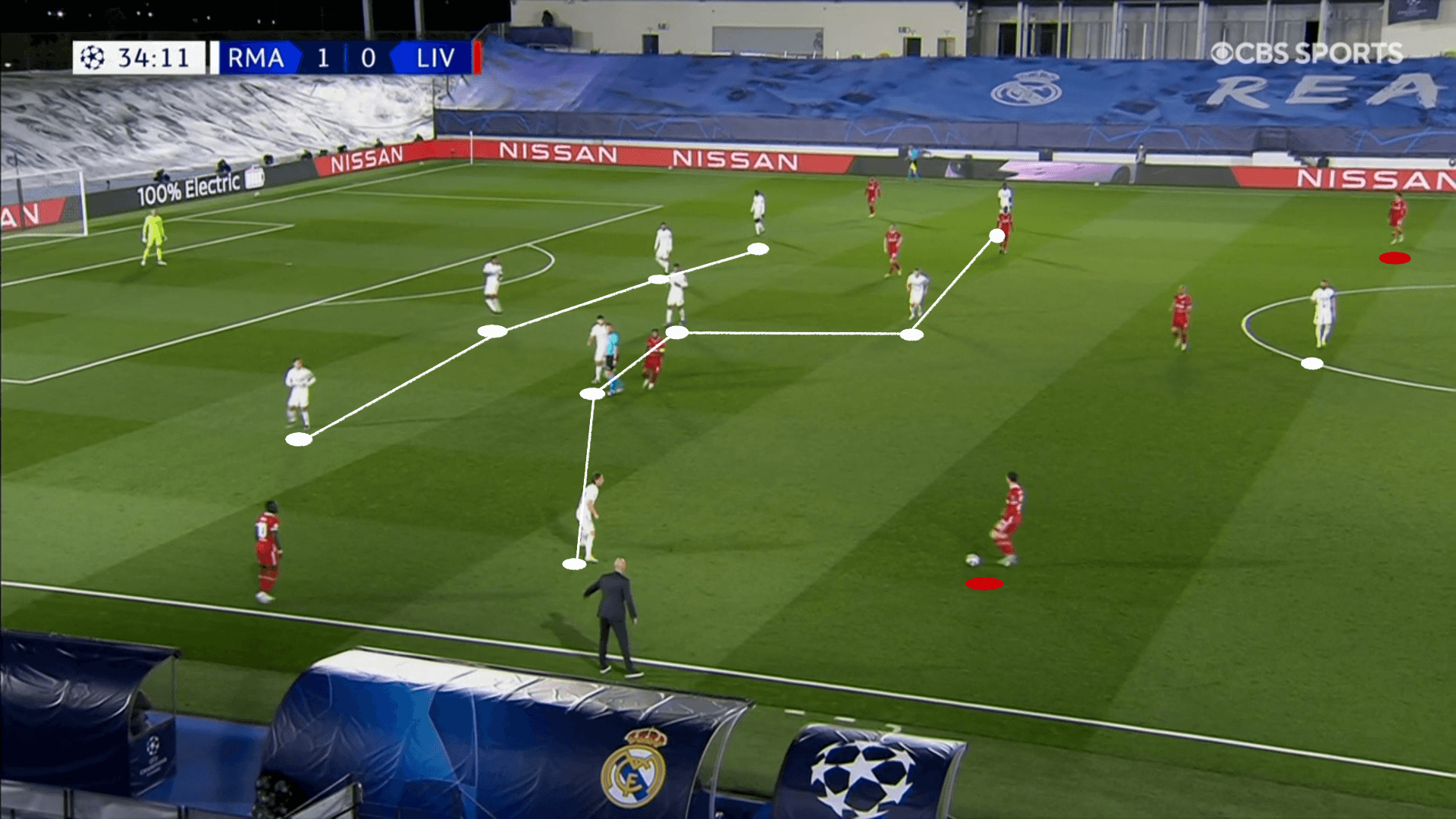
In the later stages of the game, with Real Madrid leading 3-1, we saw the two-wingers join Casemiro while Modrić and Kroos joined Benzema higher up the pitch. In the image below, the shape is a 4-3-1-2, but it was typically Modrić and Kroos pressing underneath Benzema looking to move forward if Liverpool passed along the backline.
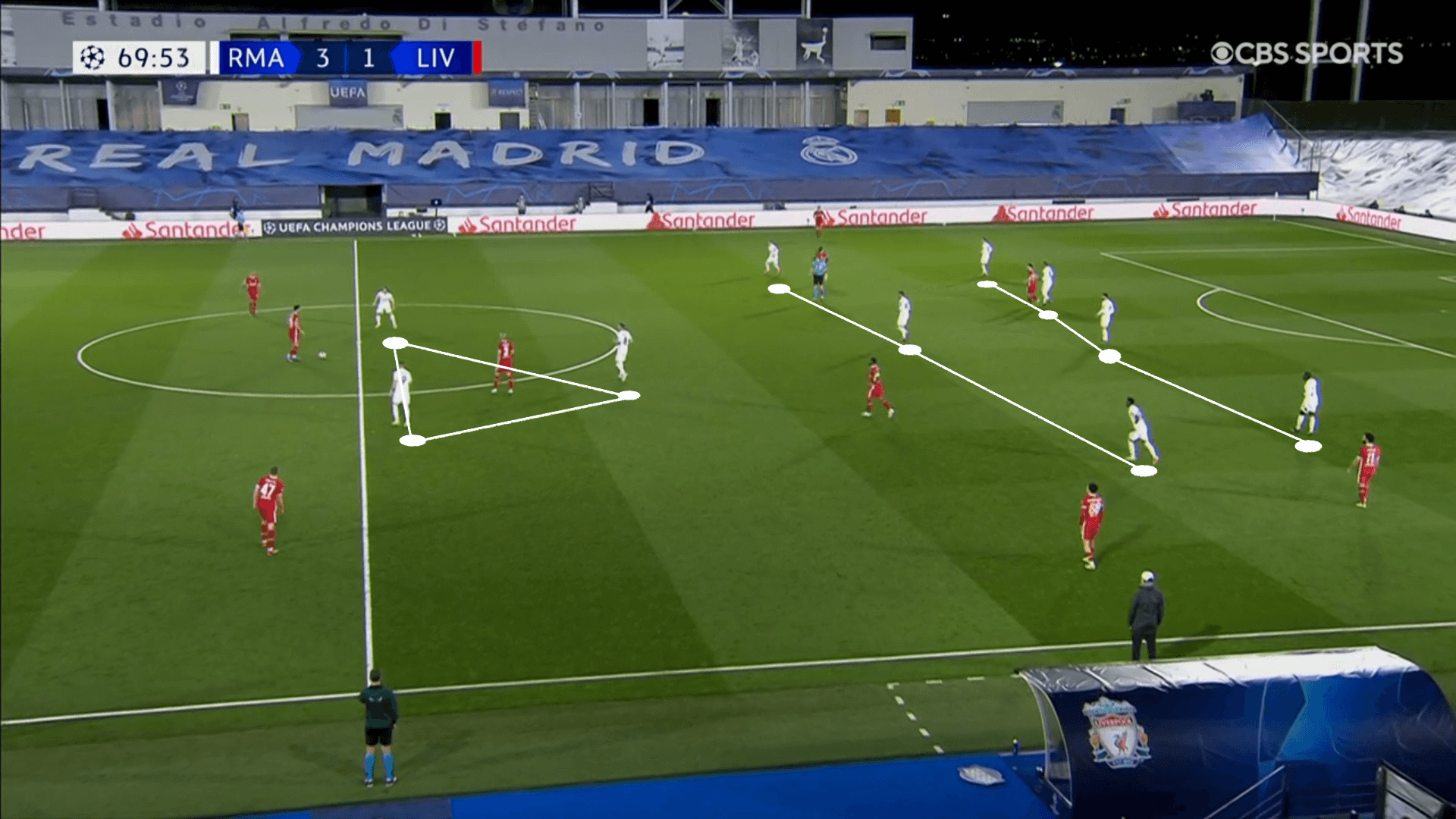
In each of these examples, we saw Real Madrid with numbers behind the ball and overloaded centrally. That central dominance limited Liverpool’s access to the central channel and half spaces, allowing them to funnel Liverpool into the wings. With Zidane’s tactics putting the onus on Alexander-Arnold and Robertson to drive Liverpool forward, the Frenchman was positioning his squad to expose the Liverpool backline through direct attacks.
Liverpool’s languid press
Throughout the first half, Liverpool was largely unsuccessful sustaining attacks in the attacking half of the pitch. Between losses high in the wings and disconnects during direct attacks, Real Madrid’s defensive approach and put Liverpool off just enough to limit the English side success.
Though Liverpool had issues sustaining a presence in Real Madrid’s half of the pitch, the ball was in that territory for the better part of the first half. From the onset, Zidane’s men signalled that they were going to test Liverpool’s high press by building out of the back. That’s a given with players like Ramos and Varane on the pitch, but even with Nacho and Militão, Zidane had faith that his players could protect the ball while drawing Liverpool higher up the pitch.
Kroos and Modrić took on their usual rolls dropping in deep to help with the build-out under more intense pressing situations, safeguarding possession while allowing Real Madrid to put the ball at their playmakers’ feet.
Additionally, it’s not often that a goalkeeper is one of the heroes of the match without making a save, but Courtois was pivotal in this match. As Real Madrid looked to build out of the back, Courtois was not only the deep release valve, but he showed extraordinary confidence on the ball, even while under pressure. As Liverpool pressured the Belgian, he showed a nice awareness of short-range pressure points while casting his glance further up the pitch in search of high targets, just as we saw in the 12th minute.
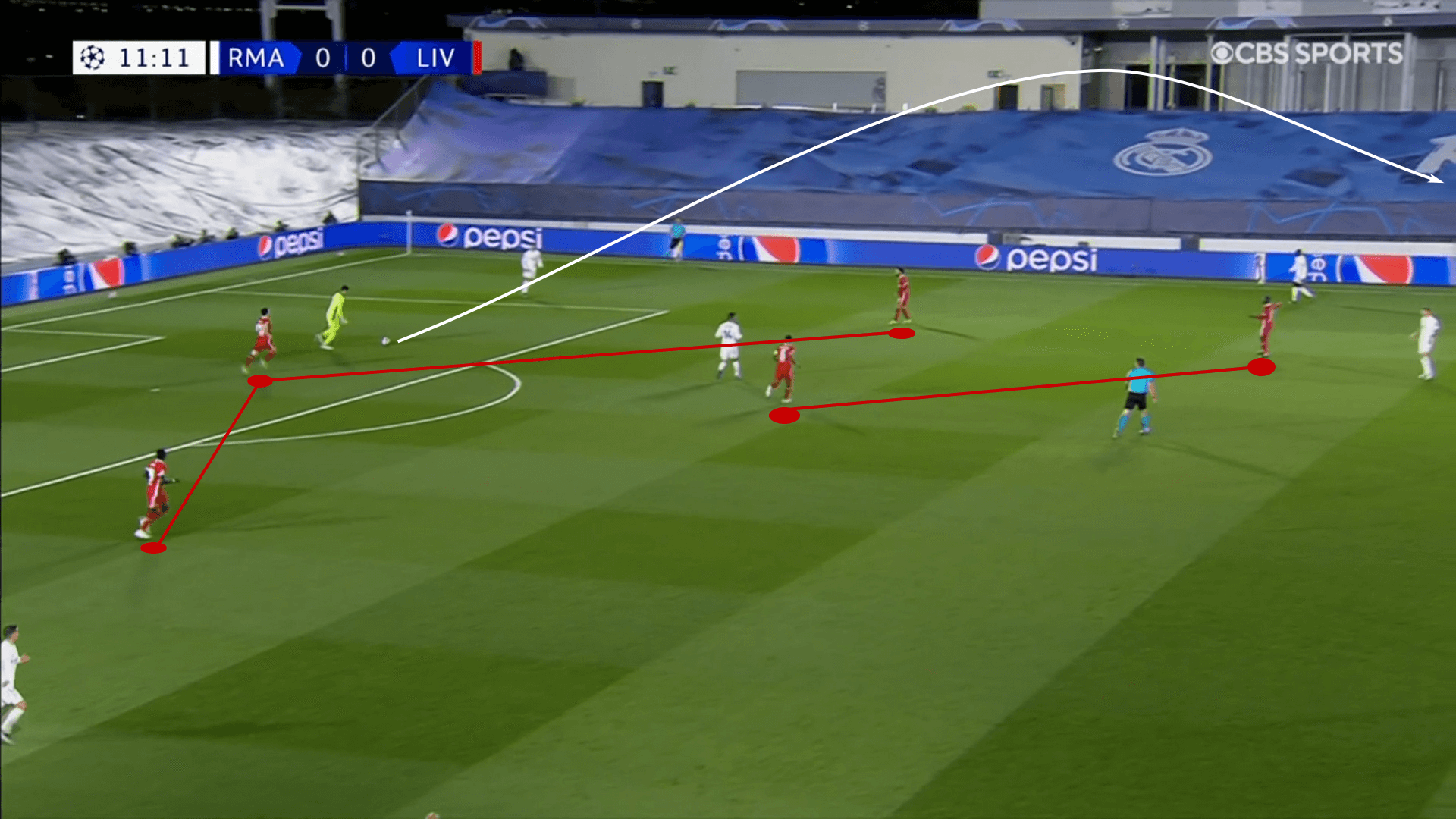
Using his passing range, Courtois was able to take advantage of the massive amount of space Liverpool was conceding behind the backline, particularly to the speedy Vinícius Júnior. Alexander-Arnold was frequently caught between the Brazilian and Mendy, often becoming disconnected from Phillips. As the gap emerged between the two, Vinícius aggressively attacked the half spaces.
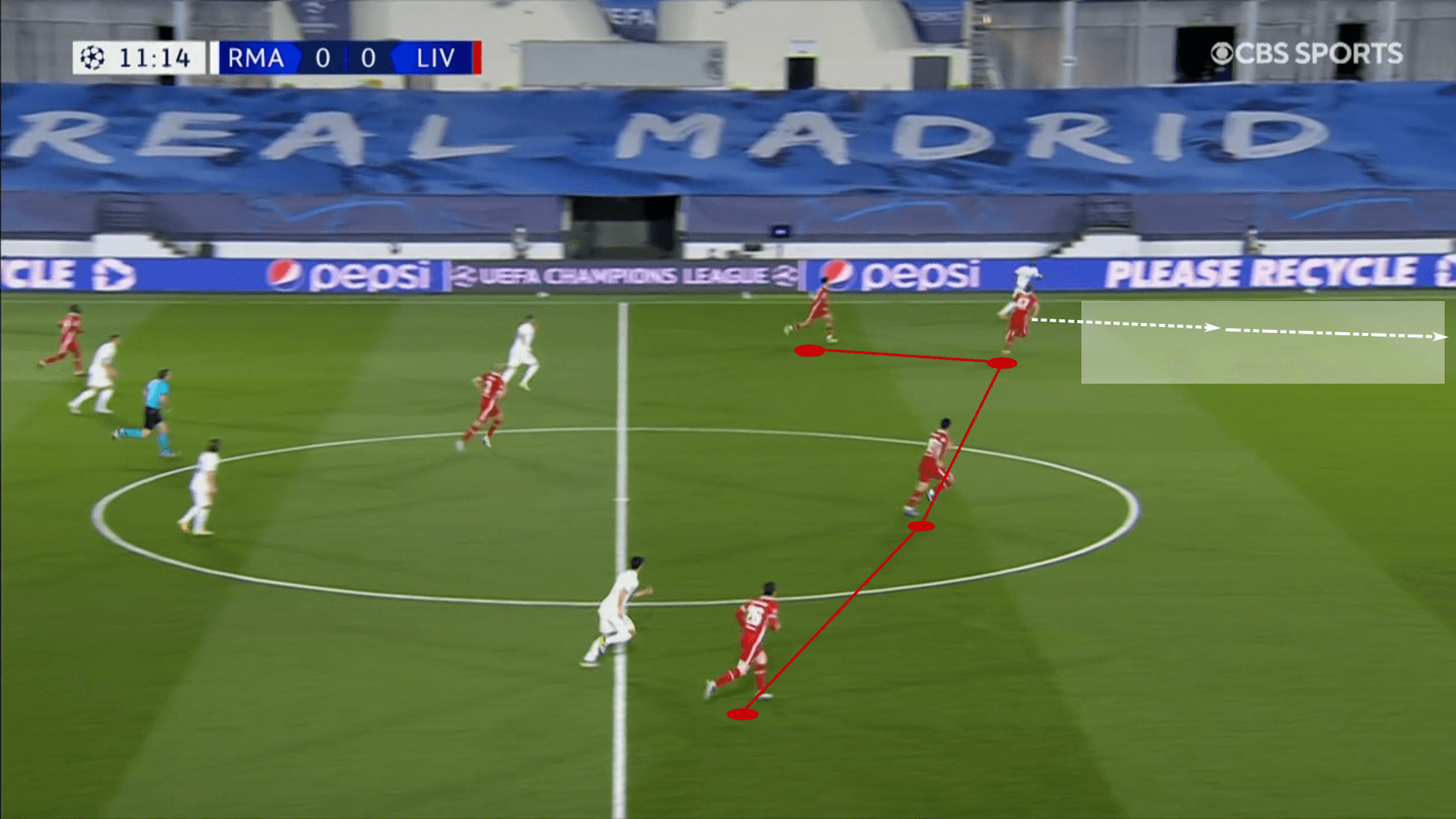
In this instance, he managed to bring the ball down in the wing, get to the end line and lead an attack that had the ball at Modrić’s feet at the top of the box.
Courtois’ excellent match as a deep playmaker greatly limited the success of Liverpool’s high press. Not only were they unable to pressure him, but the backline was unable to cope with Vinícius Júnior space. Pressing Courtois and the backline necessarily led to a high line of resistance, leaving the speedy Brazilian with a massive amount of space to run into.
But the issues weren’t exclusive to the high press. Liverpool’s middle block was just as bad, if not worse. From the backline to the forward line, we often saw the Reds occupy 22-25 meters along the vertical axis of the pitch. So, even as Real Madrid entered the middle third, often with Kroos on the ball, the Liverpool backline often lingered around the back end of the midfield circle.
The final image in the section comes moments before the first goal. The two things to point out here are 1) the general area of the pitch that Liverpool looked to cover in the middle block and 2) how Real Madrid countered through their spatial occupation.
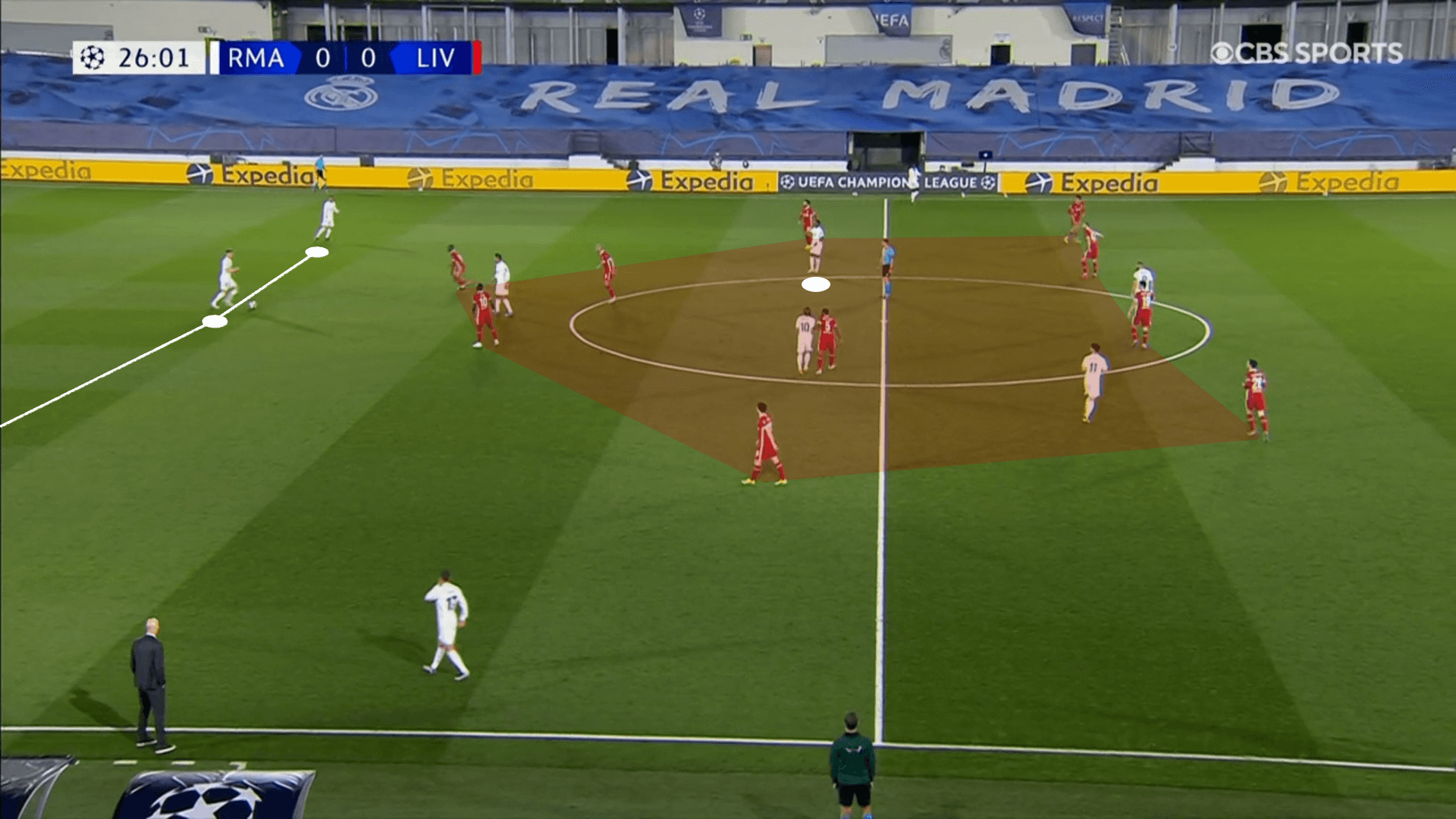
As you can see in the image, Kroos has dropped in with the backline. Dropping between these two centrebacks allowed him to move outside of Liverpool’s press, giving him more time and space to scan the field for his desired targets. Liverpool’s combination of a vertically compact middle block, little pace at the back and inability to limit Kroos’s influence in the game proved catastrophic.
Real Madrid feasted on direct attacks and TAA miscues
Before launching into Real Madrid‘s attack, we have to note Kroos’s influence in the game. The German ran the show, setting the tempo and serving as the team’s deep-lying playmaker. Aside from what was probably the worst pass of his career in the 86th minute, he was very nearly perfect in this match and was arguably the top performer, competing only with Vinícius Júnior for that title.
Looking at his long pass map, he completed 12 while only unsuccessful on two occasions. However, even one of those two unsuccessful long passes led to the second goal. He ran the show from deep and was completely unfazed by Liverpool’s press.
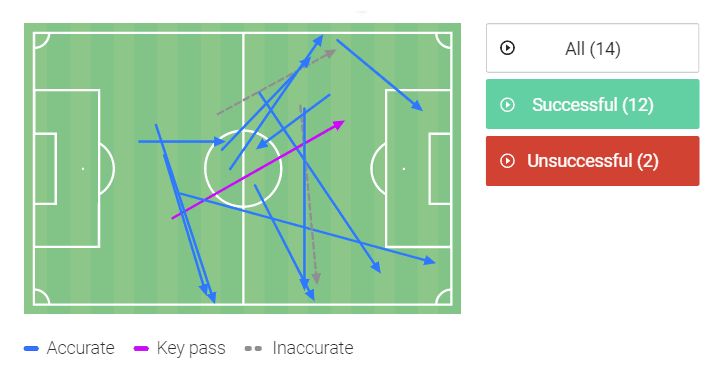
Kroos’s deep position was the perfect setup against this Liverpool high line. Leading up to Real Madrid’s first goal, we saw Liverpool’s backline just 20 meters behind Keïta, the team’s highest pressing player. As we see in the image below, the side looks like they’re prepared to funnel Real Madrid into the wings. Vázquez is largely unmarked on the right while Mendy had some space on the left. With Vinícius Júnior dropping into midfield, Alexander-Arnold slid a few meters to his right to account for Mendy, which Kroos in Vinícius Júnior were quick to identify. As Vini Jr. burst into the gap between Alexander-Arnold and Phillips, the Liverpool duo were slow to respond and unable to cut off the Brazilians path to the ball.
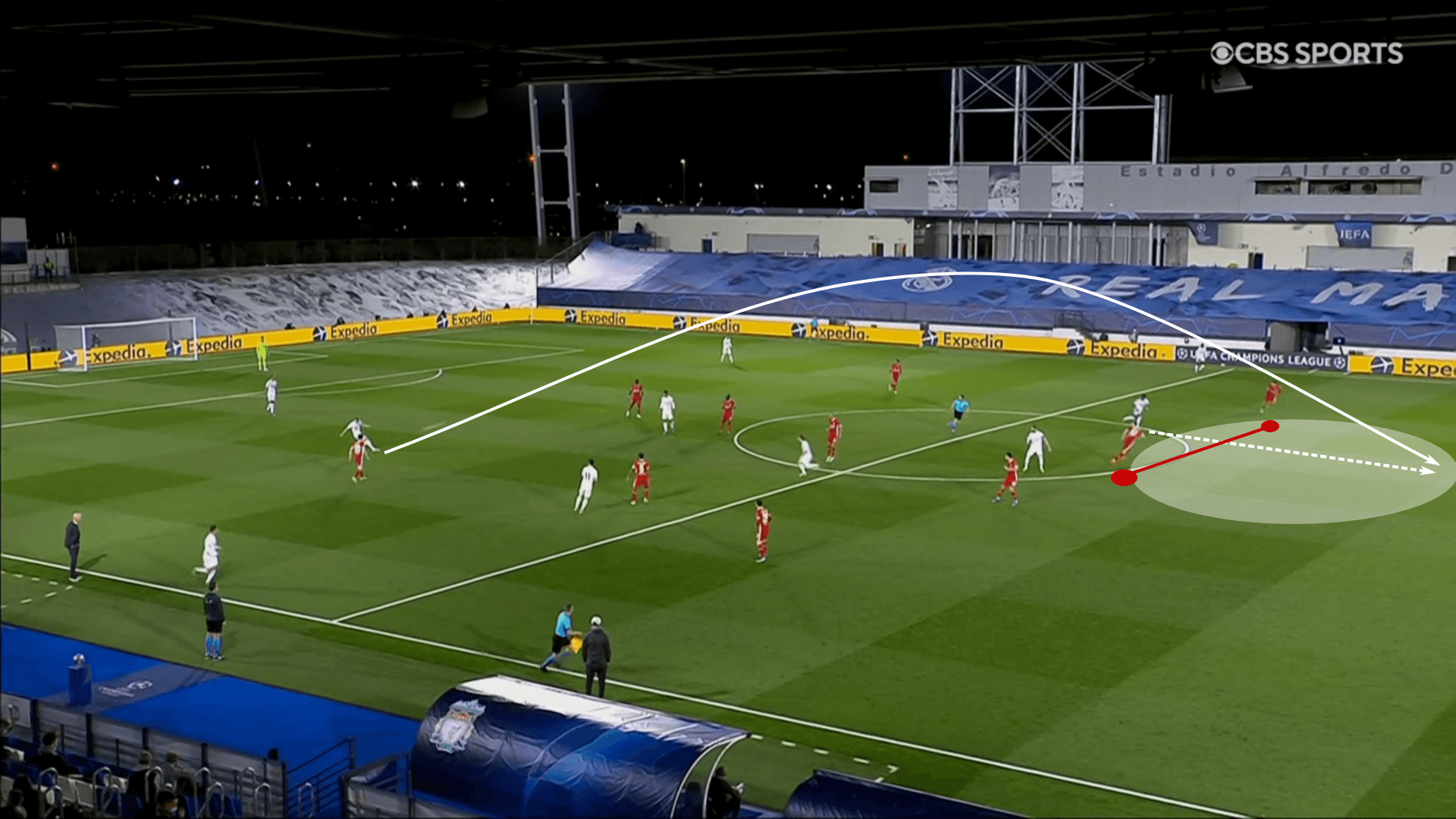
Kroos’s pass over the top was spectacular and was met by an equally brilliant first touch with the chest from Vinícius Júnior. The speedster outran the Liverpool backline and calmly slotted the ball past Alisson. For a player who has struggled with his finishing over the past few seasons, this was just the start Vinícius needed.
On the first goal, you could argue that Alexander-Arnold’s far too wide with his defensive starting point. With Kroos on the ball in the right half space, there’s no need for Alexander-Arnold to sacrifice space in the central channel and the interior of the left half space in order to defend against the long switch of play to Mendy.
On the second goal, it was again Kroos, this time in the left half space, targeting Alexander-Arnold’s defensive work. The Englishman had the inside track on Mendy and won the header, but he mistakenly put it into the path of Asensio. Although the Spaniard had not offered much to the Madrid attack in this match, he was his opportunistic, lethal self in front of goal.
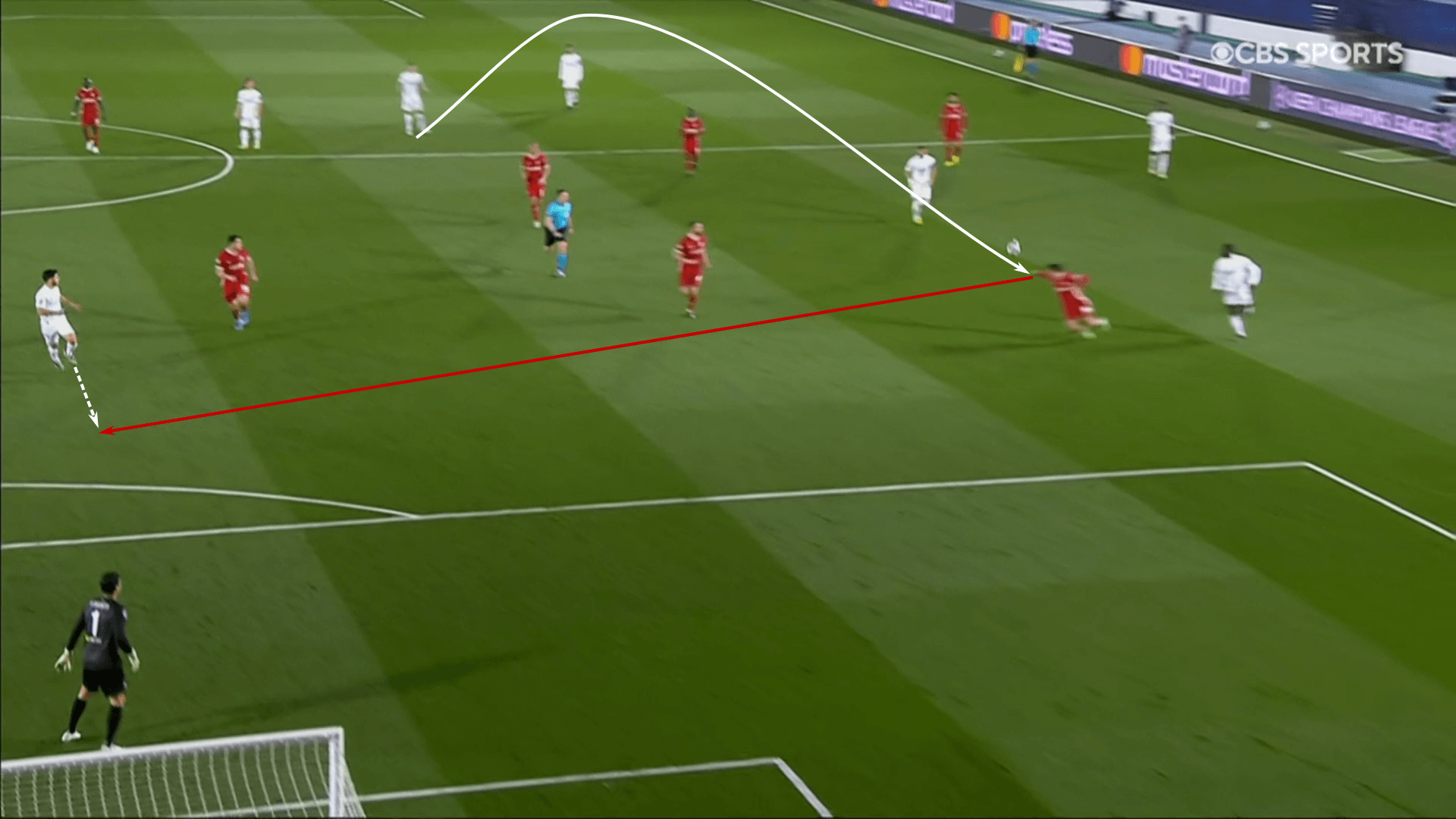
It was obvious in the early stages of the match that Real Madrid intended to pick on Alexander-Arnold, testing his defensive mettle and his connection with Phillips. TAA’s frustration was evident with his 83rd-minute yellow card. Vinícius Júnior tormented him all match and limited his contribution going forward. On the night, Alexander-Arnold sent five crosses, completing just one. Given the number of times Real Madrid had victimized him, particularly through the pace of Vinícius Júnior, the young Englishman seemed hesitant to get forward knowing Real Madrid’s plan to attack the space behind him.
Without his attacking contributions, he had to lean more heavily on his defensive work, which was exposed again on the third Real Madrid goal.
Off a throw-in, Real Madrid managed a nice sequence to break Liverpool’s pressure in the wing and drive into the box. Vinícius Júnior initially started on the back shoulder of Alexander-Arnold, who we can see has his back to the Brazilian. Unaware of his opponent’s movement, Alexander-Arnold didn’t pick up the Vini Jr.’s run towards the penalty spot, nor did Phillips respond quickly enough to account for his teammate’s lack of awareness.
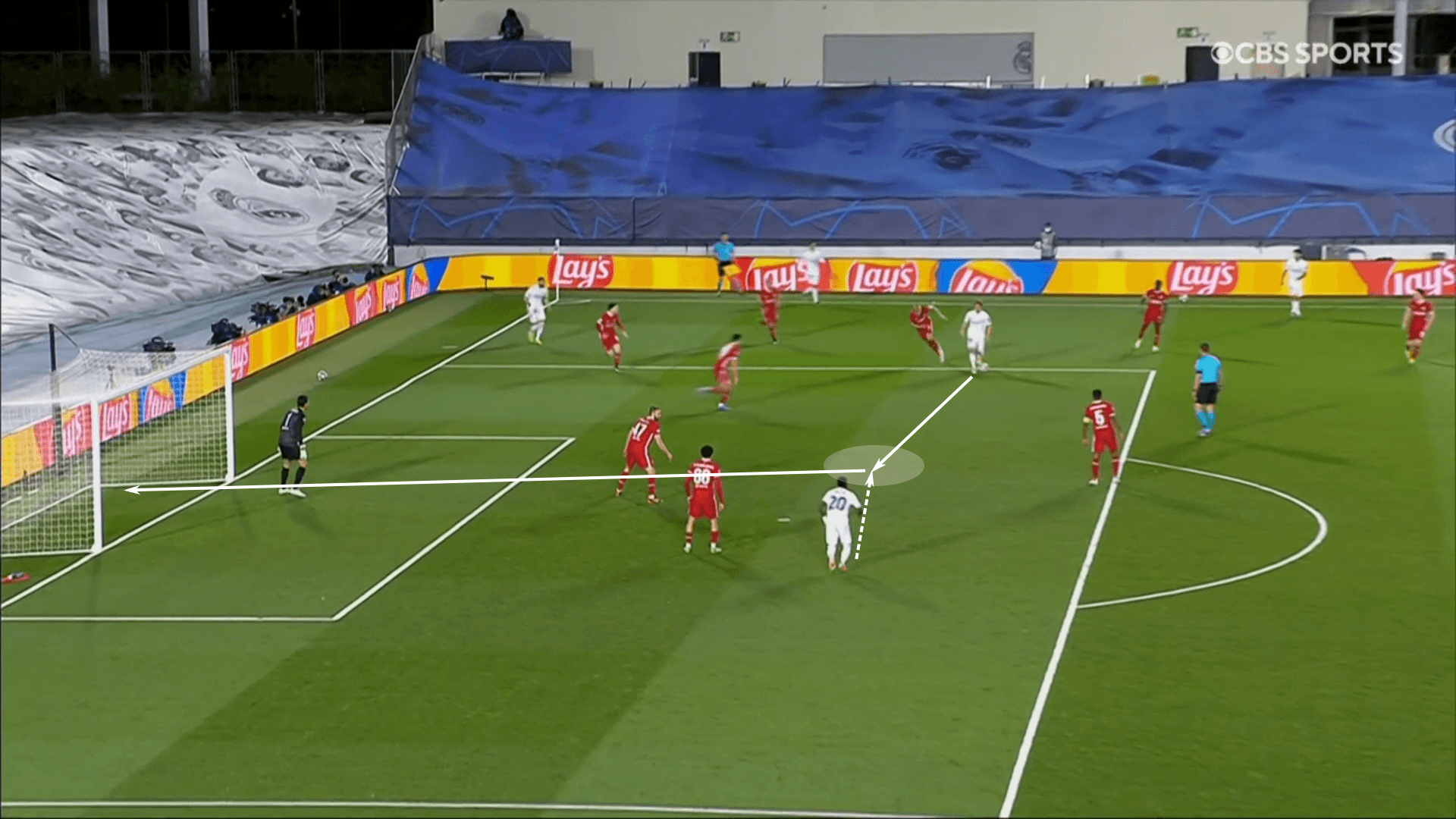
Though Alisson could have done better on the shot, it was a nice hit from the young Brazilian, restoring the two-goal cushion to close out the first leg. With this performance, expect Vinícius Júnior to be back in starting lineup for the second leg even if Hazard is available. Liverpool, and especially Alexander-Arnold, simply couldn’t handle his pace and were victimized by his newfound finishing touch.
Conclusion
In the battle of defending EPL and La Liga champions, it was the Spanish side that ran out to a comfortable victory.
Through Liverpool did manage a few runs into the box off of Real Madrid’s miscues and defensive lapses, this analysis shows that, on the whole, they struggled to create scoring opportunities with any level of consistency. The one shot on target testifies to Zidane’s defensive tactics and the performance of his team.
As the tie heads to Anfield, Real Madrid will go in with confidence that they can get a goal. Liverpool’s high press never threatened them and the middle block conceded far too much space for Real Madrid’s direct attacking. With Liverpool needing at least two goals in the second leg, it’s difficult to envision the Premier League club being less open defensively.
Unable to contend with Real Madrid’s direct attacks or their central dominance, Klopp will have a lot of questions to answer before the second leg.
For Zidane, he and his men have a tough matchup over the weekend, facing Barcelona in El Clásico (tactical preview available tomorrow on Total Football Analysis). He certainly won’t hold any punches this weekend, so there is an opportunity for Liverpool to rest up before running up against weary legs.





Comments